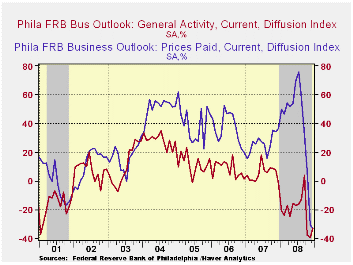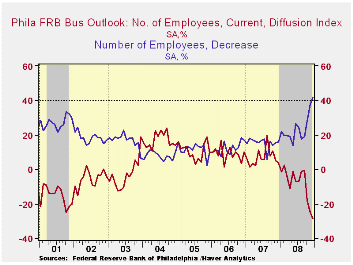 Global| Dec 18 2008
Global| Dec 18 2008Philadelphia Fed Index Ticked Up in December But Still Near Cycle Low
by:Tom Moeller
|in:Economy in Brief
Summary
The Philadelphia Federal Reserve Bank indicated, with its December Business Activity Index, a level of U.S. economic weakness that rivals the lows of the series' forty year history. The bank reported that its December Index of General [...]

The Philadelphia Federal Reserve Bank indicated, with its December Business Activity Index, a level of U.S. economic weakness that rivals the lows of the series' forty year history. The bank reported that its December Index of General Business conditions in the manufacturing sector did improve slightly from November to -32.9 from this cycle's November low of -39.2, but the latest was still near the lowest level since the recession of 1990. It also wasn't far above the lows of earlier recessions. A reading of -40 had been expected for this month.
During the last ten years there has been a 61% correlation between the level of the Philadelphia Fed Business Conditions Index and the three-month growth in factory sector industrial production. There has been a 43% correlation with q/q growth in real GDP.
The Philadelphia Fed constructs a diffusion index for total business activity and each of the sub-indexes. The business conditions index reflects a separate survey question.
Amongst the sub-indexes, the new orders index improved the most m/m to its highest level since September. However, it remained quite negative and near the lowest level since the recession of 1990. The shipments index deteriorated to a new cycle low. 
The employment index fell another 3.5 points to a new cycle low and that was the lowest level since the recession year of 1982. Forty two percent of respondents expected to reduce employment levels, the highest since 1981, while only 12.9% expected to raise them. During the last ten years there has been a 79% correlation between the index level and the m/m change in manufacturing sector payrolls.
The prices paid index fell to another record low of -33.2. During the last ten years there has been a 67% correlation between the prices paid index and the three-month growth in the intermediate goods PPI. There has been an 82% correlation with the change in core intermediate goods prices.
The separate index of expected business conditions in six months also fell to near its lowest level since 2001. The expectations index for new orders fell further to a new cycle low. The expectations index for employment fell to a new record low while the expected prices paid figure fell further to a new record low.
The latest Business Outlook Survey from the Federal Reserve Bank of Philadelphia can be found here.
| Philadelphia Fed (%) | December | November | December '07 | 2008 | 2007 | 2006 |
|---|---|---|---|---|---|---|
| General Activity Index | -32.9 | -39.3 | -1.6 | -21.2 | 5.1 | 8.1 |
| Prices Paid Index | -33.2 | -30.7 | 36.5 | 36.1 | 26.4 | 36.6 |
Tom Moeller
AuthorMore in Author Profile »Prior to joining Haver Analytics in 2000, Mr. Moeller worked as the Economist at Chancellor Capital Management from 1985 to 1999. There, he developed comprehensive economic forecasts and interpreted economic data for equity and fixed income portfolio managers. Also at Chancellor, Mr. Moeller worked as an equity analyst and was responsible for researching and rating companies in the economically sensitive automobile and housing industries for investment in Chancellor’s equity portfolio. Prior to joining Chancellor, Mr. Moeller was an Economist at Citibank from 1979 to 1984. He also analyzed pricing behavior in the metals industry for the Council on Wage and Price Stability in Washington, D.C. In 1999, Mr. Moeller received the award for most accurate forecast from the Forecasters' Club of New York. From 1990 to 1992 he was President of the New York Association for Business Economists. Mr. Moeller earned an M.B.A. in Finance from Fordham University, where he graduated in 1987. He holds a Bachelor of Arts in Economics from George Washington University.






